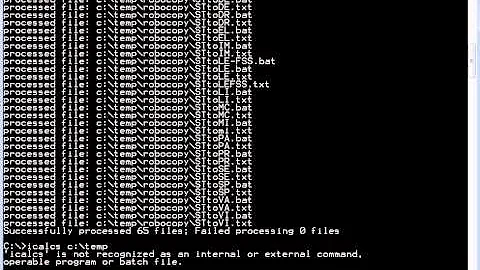Regardless of Windows language, how can I make the ICACLS command set a folder to have full access to everyone?
Solution 1
Does not work in French versions, presumably due to Users being different
You have three options, detailed below:
Use the Use the Language Portal to get the translated name
Retrieve the localised name from the
UsersSIDUse the
UsersSID withicacls
Option 1: Use the Language Portal (canonical resource for Microsoft Terminology)
A search for Users returns:
Translations in Localized Microsoft Products
English Translation Product
Users Utilisateurs Windows 7
Users des utilisateurs Windows 7
Users Utilisateurs Windows 8 Modern Voice
Users Utilisateurs Windows 8
Users Utilisateurs Windows 8.1
USERS UTILISATEURS Windows 8.1
Users Utilisateurs Windows 10
Users des utilisateurs Windows 10
Users Utilisateurs Windows 10 Anniversary Update
users utilisateurs Windows 10 Anniversary Update
This suggests the following command may work:
icacls C:\FullyAccessibleFolder /grant Utilisateurs:(OI)(CI)F
Option 2: Retrieve the localised name from the Users SID (S-1-5-32-545)
SID: S-1-5-32-545
Name: Users
Description: A built-in group. After the initial installation of the operating system, the only member is the Authenticated Users group. When a computer joins a domain, the Domain Users group is added to the Users group on the computer.
Source Well-known security identifiers in Windows operating systems
To retrieve the localised Users group name:
This simple script will give you actual name of 'Users'
(S-1-5-32-545)group on a given PC:Set objWMIService = GetObject("winmgmts:\\.\root\cimv2") Set objAccount = objWMIService.Get ("Win32_SID.SID='S-1-5-32-545'") Wscript.Echo objAccount.AccountNamePut it into a file with vbs extension (Let's assume
usersName.vbs).Now run:
echo Y|for /f "delims=" %i in ('cscript -Nologo usersName.vbs') do cacls foldername /G "%i":F
Source Cacls, Windows 7, full permissions, local names by wmz
Option 3: Use the Users SID with icacls
Use the following command:
icacls C:\FullyAccessibleFolder /grant *S-1-5-32-545:(OI)(CI)F
Source comment by Harry Johnston
Solution 2
You need to specify the AD-group not by its name, but by the SID number.
For standard groups like "EveryOne", "Domain Users", etc. there are standardized SID numbers, which can be found on the MSDN page Well-known security identifiers (SIDs).
The following are the most common relative identifiers.
The structure of a SID is describe as the following:
The components of a SID are easier to visualize when SIDs are converted from binary to string format by using standard notation:
S-R-X-Y1-Y2-Yn-1-Yn
Component Definition S Indicates that the string is a SID R Revision level X Identifier authority value Y A series of subauthority values, where n is the number of valuesFor example, the SID for the built-in Administrators group is represented in standardized SID notation as the following string:
S-1-5-32-544
This SID has four components:
A revision level (1)
An identifier authority value (5, NT Authority)
A domain identifier (32, Builtin)
A relative identifier (544, Administrators)
Solution 3
If you like PowerShell scripts but have trouble remembering numbers for SIDs:
$acl = Get-Acl .\myfolder
$sid = New-Object System.Security.Principal.SecurityIdentifier ([System.Security.Principal.WellKnownSidType]::BuiltinUsersSid, $null)
$rule = New-Object System.Security.AccessControl.FileSystemAccessRule ($sid, 'FullControl', 'ObjectInherit,ContainerInherit', 'None', 'Allow')
$acl.AddAccessRule($rule)
Set-Acl .\myfolder $acl
I know that looks like a ton of typing, but these long identifiers are tab-completed:
-
System.Security.Principal.SecurityIdentifierfromsecurityi -
System.Security.Principal.WellKnownSidTypefromwellknownsi -
System.Security.AccessControl.FileSystemAccessRulefromfilesystem
All these strings are .NET identifiers, so they don't get localized.
If you want the Everyone SID instead, use WorldSid in place of BuiltinUsersSid. To get the list of all WellKnownSidType options, see MSDN or run this command:
[System.Security.Principal.WellKnownSidType].DeclaredFields | select Name
Related videos on Youtube
Geesh_SO
Updated on September 18, 2022Comments
-
Geesh_SO over 1 year
Background
Say I have this command
icacls C:\FullyAccessibleFolder /grant Users:(OI)(CI)FThis works fine in English versions of Windows, but does not seem to work in French versions, giving the following error, presumably due to
Usersbeing different in French.Everyonegets translated asTout le mondein Windows, so that's not a solution either.Users: Le mappage entre les noms de compte et les ID de sécurité n'a pas été effectué.Which Google translates as
Users: The mapping between account names and security IDs was not performed.Question
Is there a command I can use to set a folder and recursively all of its contents to have full permissions for all users in a way that would work across different language versions of Windows?
Content from around the web
This page with a largely similar problem talks about how
EveryonebecomesJederin German andTout le mondein French.-
Ben about 7 yearsJust use the SID:
icacls C:\FullyAccessibleFolder /grant S-1-5-32-545:(OI)(CI)FWorks everywhere. -
Harry Johnston about 7 years@Ben, that should be
icacls C:\folder /grant *S-1-5-32-545:(OI)(CI)F, you left out the asterisk.
-
-
Ramhound about 7 yearsIt is worth pointing out that all users are part of the User group by default. So if you want to give "full access:to all user accounts, just use SID
S-1-5-32-544, and then modify the ACL to give all permissions to the group for the file or folder in question -
 DavidPostill about 7 years@Ramhound
DavidPostill about 7 years@Ramhound544is Administrators,545is Users. -
Ramhound about 7 years@DavidPostill - Yes; Copy and paste error.
-
Geesh_SO about 7 yearsI've accepted the answer from DavidPostill as it does it in a true command line way, which is great when using batch or PS scripts. In the end I actually created a little executable in C# which just takes a path and does exactly what I need to. It's not as customisable as the answers here, and it requires .NET Framework, but it does suit my particular purpose very well. If anyone is interested, here is the the basis of the C# code I ended up going with. stackoverflow.com/a/35461832/1639615
-
Tonny about 7 years@Ramhound Much better. It was the best I could do while being on a phone. Thank for the edit.
-
Harry Johnston about 7 years
xcaclsappears to be a script you can download. There's no need;icaclsis built into Windows and can do the same job. -
 DavidPostill about 7 years@HarryJohnston Correct, but my answer is showing how to retrieve the localised version of
DavidPostill about 7 years@HarryJohnston Correct, but my answer is showing how to retrieve the localised version ofUsers... I've clarified the answer as we don't need thexaclspart of the quoted solution. -
 DavidPostill about 7 years@HarryJohnston I've also added using
DavidPostill about 7 years@HarryJohnston I've also added usingicaclsdirectly with credit to you. -
 Kiquenet almost 6 yearsFileSystemAccessRule without Sid and using
Kiquenet almost 6 yearsFileSystemAccessRule without Sid and usinggroup names? -
 Ben N almost 6 years@Kiquenet I'm not entirely sure what you're asking, but if you prefer to specify a human-readable group name, that will no longer be language-independent. If you're OK with that, you can remove the
Ben N almost 6 years@Kiquenet I'm not entirely sure what you're asking, but if you prefer to specify a human-readable group name, that will no longer be language-independent. If you're OK with that, you can remove the$sid =line and replace$sidin the$rule =line with a string identifying the group. -
urxter over 2 yearsThis is exactly what I wanted to achieve in Powershell. I can confirm that this works independent of the system language and is unaffected by the localized name for
BUILTIN\Users(VORDEFINIERT\Userson German systems for example).








